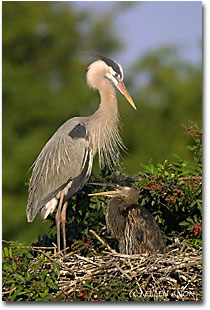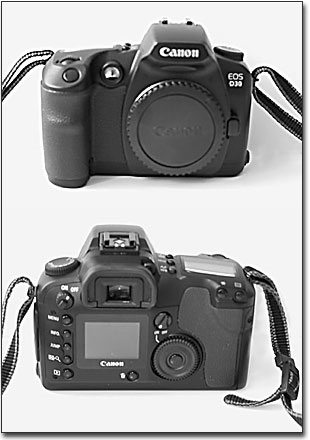|
 I love photography equipment - from camera bodies to lenses to accessories, I love to try out new things. Although I have had a digital darkroom for several years, regularly scanning slides and editing them in Photoshop, I was intimidated by digital cameras. Admittedly I was tempted - I'd look as people were being shown the latest models in a local camera store, and I read the ads and reports. But somehow it all seemed very intimidating. I've always been very comfortable with SLRs - whether 35mm or medium format, but point and shoots - which are supposed to be so easy - always cause me trouble. I never seem to know exactly what the camera is thinking or planning to do with all those cute little icons - or how it's metering a scene. And most of the digital cameras I saw presented all those difficulties along with something I'd never previously encountered - white balance. So I waited. I'm a dedicated Canon shooter and I knew eventually Canon would come out with a digital camera that would be tempting.
I love photography equipment - from camera bodies to lenses to accessories, I love to try out new things. Although I have had a digital darkroom for several years, regularly scanning slides and editing them in Photoshop, I was intimidated by digital cameras. Admittedly I was tempted - I'd look as people were being shown the latest models in a local camera store, and I read the ads and reports. But somehow it all seemed very intimidating. I've always been very comfortable with SLRs - whether 35mm or medium format, but point and shoots - which are supposed to be so easy - always cause me trouble. I never seem to know exactly what the camera is thinking or planning to do with all those cute little icons - or how it's metering a scene. And most of the digital cameras I saw presented all those difficulties along with something I'd never previously encountered - white balance. So I waited. I'm a dedicated Canon shooter and I knew eventually Canon would come out with a digital camera that would be tempting.
Initial Impressions
Late last year I succumbed to temptation and bought a Canon D30 after several of my regular photobuyers assured me they would accept digital files. The D30 is a major departure from most digital cameras because it uses almost all the regular lenses in the Canon lineup - just like my EOS 1V and the rest of their line-up. Although it is a digital camera, it is set up like the rest of their SLRs, which immediately made it seem much more user friendly. No weird twisting bodies making me wonder which side is up. Just a body that clearly is a relative of the other EOS bodies, and is easy to hold, with a few obvious changes such as the LCD screen on the back.
In fact most of the main controls from Canon's film based bodies are in the expected place on the D30 - including the shutter release, main dial, quick Control dial, AE lock button, status LCD, mode dial and lens release. What's different are the controls specific to the digital capture and review which are placed near the LCD screen on the left side of the back of the camera. Note that with the D30 you have the expected viewfinder to use for framing your shots rather than needing to rely on the LCD screen. (LCD screens are notorious for being battery hogs.) Unfortunately the viewfinder is less than a 100% viewfinder - so after you take the image , what appears on the LCD screen will be just slightly different - like with the non-pro models of the film cameras.
I was pleasantly surprised to find that using the D30 was amazingly intuitive based on my familiarity with the other EOS bodies. Canon included the picture icons for those who like them, but the standard aperture and shutter priority exposure modes are right there too. Similarly you can set the metering pattern to use Canon's evaluative metering, center weighted or partial center weighted metering systems. But a bonus is the ability to set the ISO (actually the digital equivalent, but nicely termed ISO for those of us who think in those terms!) for each shot individually. You can set the ISO from 100 -1600 on the D30, but the manual cautions that there is more noise (distortion) at the higher ISOs. So I generally keep it at 100 unless I really need the speed for a certain shot. But at last the flexibility to use the ISO you need for a shot, without having to change film or "push" an entire roll! By the way, the shutter speeds range from 30 seconds to 1/4000 of a second!
Some of the Details
The D30 uses a CMOS (complimentary metal oxide semiconductor) chip. I won't go into the details of this technology - just know that it is slightly different than the CCD chips used in many of the other cameras. Apparently Canon modified this technology to eliminate the problems associated with it and gain the benefits of much better power consumption and lower cost. It has a pixel count of 3.25million megapixels. (see www.usa.canon.com for more details and full specs.) Because the chip is physically smaller than a frame of 35mm film, the effective length of your lenses increases by a factor of 1.6. This means a 28 - 135mm lens becomes a 45 - 216mm lens, while a 100 - 400 becomes a 160 - 640. Very nice for those who enjoy using telephoto lenses, but a bit of a problem for those who love super wide-angle shots.

There are a variety of options as to what resolution you can use to record your images. These range from the Raw mode - an uncompressed, lossless TIFF format to JPEG large/fine, to low/normal . Since I want to be able to use my images professionally I primarily use the raw or jpeg large/fine. These result in images of roughly 3MB. When the raw images are converted into TIFF images in a computer, they will be about 9 MB. This is large enough for excellent 8 X 12 prints without any help from outside software such as Genuine Fractals. The camera is capable of capturing 3fps for a sequence of 8 frames before it has to pause to write to the memory card, when shooting in Large/Fine mode.
The D30 accepts both Type I and Type II compact flash cards as well as the IBM Microdrive cards. I use the 1 GB Microdrive card so that I don't have to worry about constantly running out of memory space.
One of the advantages of a digital camera is also that you can immediately view the image you just shot on the LCD screen and delete it if it's not what you hoped for. That way you immediately know when you have to reshoot, and when you have your shot. There is a little button you can push when viewing the image on the LCD screen called information. This gives you a histogram indicating the range of tonalities in your picture. Further, areas which might be overexposed flash to warn you to try again with a different setting or exposure compensation - just like you might do with a film camera. That's one of the things that's so nice about this camera- it relates to the user in familiar terms!
As for "white balance" so far I've opted to leave it in the automatic mode and let the camera do the thinking for me. It has worked excellently both indoors and outdoors. Perhaps as I become more digitally sophisticated, I'll view this the same way I view other automatic modes. If so, the D30 offers the option to set the white balance manually for those who so desire. But for now I'm very content to have the camera take care of these decisions for me.
The D30 uses a rechargeable battery, and you'll probably want more than one as a backup if you are doing a lot of shooting. There is also an option to buy an external battery pack holding two of these batteries, but I've found no need for that so far. I prefer the lightness of the camera without it.
Other familiar features include a built in pop-up flash which is handy, but also allows the use of your regular Canon flash. There are three focusing spots from which you can choose, the middle one being the most sensitive with both vertical and horizontal crosshairs - the others are horizontal only. One of the drawbacks to the camera is that many feel the autofocusing is not as efficient as that used in other Canon cameras - it tends to be slower - which can be important when shooting sports or some types of wildlife such as animals in motion. Of course you can always revert to manual focusing or rely heavily on the center sensor when autofocusing.
Canon includes a proprietary software program to help transfer images into your computer. Some feel this program works well - especially when using jpeg images and a PC. Be aware that the procedure is extremely time consuming and clumsy when downloading RAW images which must be converted into TIFF format, particularly when using a MAC. I've spoken to Canon tech support as well as several field reps and all hope (as do I!) that a revised version of the software becomes available soon.
Bottom Line
At a street price of nearly $3000, the D30 is not inexpensive, although it is significantly less than other SLR digital cameras at this point. The images I've taken with it are impressive in terms of color fidelity as well as detail and crispness of final image. I assume part of this is due to the ability to use regular optical lenses with the camera rather than "point and shoot" type lenses. As a matter of fact, I made an electronic submission to one of my buyers of images shot both with the D30 and with my 1V (scanned on a Polaroid Sprintscan 4000 and tweaked in Photoshop). The buyer commented that if anything, the D30 images were sharper! I have also found the D30 records more shadow detail than with my slide film.
All in all, this camera is a pleasure to use, delivers excellent images, and is an easy introduction into the world of digital cameras.


| 
